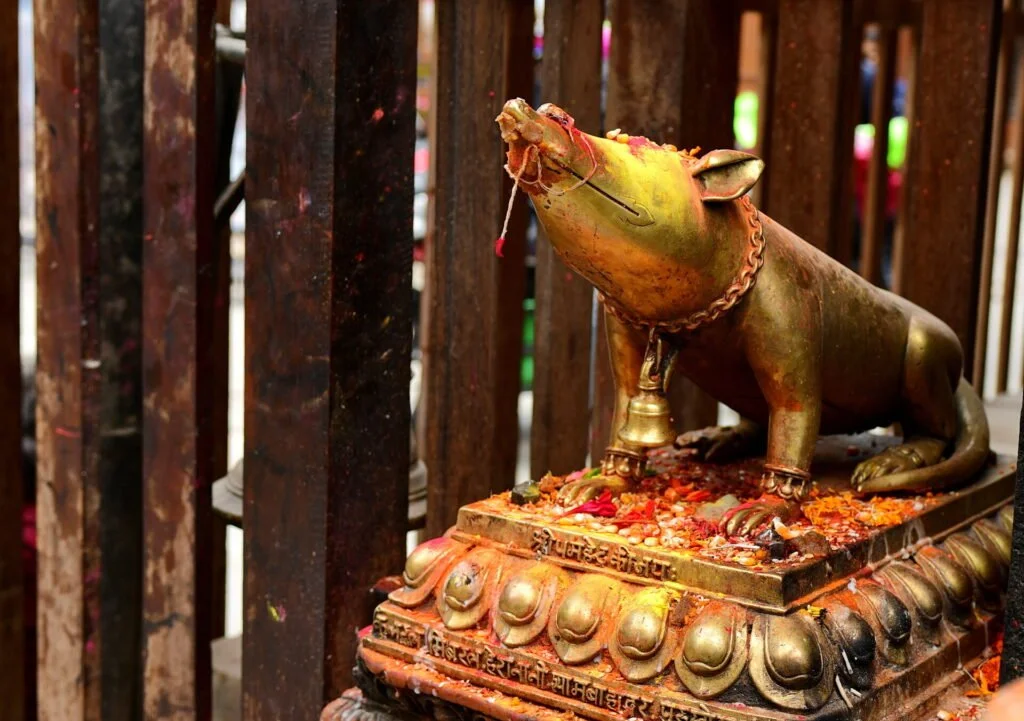Ashok Binayak Temple: A Holy Shrine of Lord Ganesh in Kathmandu
The Ashok Binayak Temple, also known as Maru Ganesh Temple, is a revered Hindu temple located in the eastern part of Kathmandu Durbar Square in Maru Tole, Kathmandu. This ancient temple is dedicated to Lord Ganesh, the elephant-headed deity and the son of Lord Shiva and Goddess Parvati. Lord Ganesh is worshipped as the god of luck and the remover of obstacles by Hindus.
The Ashok Binayak Temple is one of the four original Ganesh shrines in the Kathmandu Valley, along with Chandra Binayak, Surya Binayak, and Jal Binayak. It holds great religious significance and is considered a sacred place of worship for both Hindus and Buddhists.
The temple is often frequented by devotees, who visit to seek the blessings and divine intervention of Lord Ganesh. The day of Tuesday is considered particularly auspicious, and devotees throng the temple in large numbers on this day of the week. It is believed that offering prayers and making offerings to Lord Ganesh at this temple can bring good luck, prosperity, and success in endeavors.
The architecture of the Ashok Binayak Temple is breathtaking, reflecting the rich cultural heritage of Nepal. The beautiful temple structure showcases intricate carvings and designs, showcasing the craftsmanship of the artisans of the bygone era. The temple is built in the traditional pagoda style, with a multi-tiered roof, ornate wooden carvings, and vibrant colors that create a mesmerizing sight.
Within the temple complex, there are various other smaller shrines dedicated to different deities, adding to the spiritual aura of the place. The peaceful ambiance and the serenity of the surroundings make it an ideal spot for meditation and introspection.
The Ashok Binayak Temple not only holds religious significance but also plays a vital role in preserving the cultural heritage of Nepal. It serves as a testament to the deep-rooted faith and devotion of the people towards Lord Ganesh and their rich religious traditions.
Visiting the Ashok Binayak Temple is not only a religious experience but also an opportunity to immerse oneself in the vibrant culture and traditions of Nepal. The temple is situated in close proximity to the Hanumandhoka Durbar Square area, a UNESCO World Heritage Site, which further adds to its allure.
History of Ashok Binayak Temple
The Ashok Binayak Temple, located in the Hanumandhoka Durbar Square area of Kathmandu, has a rich history that dates back several centuries. This sacred Hindu temple is dedicated to Lord Ganesha, also known as Binayak, who is worshipped as the god of luck by Hindus. It is one of the four original Ganesh shrines in the Kathmandu valley, making it a significant place of worship for both Hindus and Buddhists.
The temple is situated in Maru Tol, an area known for its cultural and religious significance. It is believed to have been built during the reign of the Malla dynasty, which ruled over the Kathmandu valley from the 12th to the 18th century. The Malla kings were great patrons of the arts and devoted to their religious practices, leading to the construction of numerous temples and religious structures in the region.
The Ashok Binayak Temple has undergone several renovations and restorations over the centuries. The name “Ashok Binayak” is derived from the Sanskrit words “Ashok” meaning “without sorrow” and “Binayak” referring to Lord Ganesha. This name signifies the belief that worshipping Lord Ganesha at this temple brings joy, prosperity, and the removal of obstacles from one’s life.

Structure and Architecture of the Maru Ganesh Shrine
Unlike other grandiose temples in the region, the Ashok Binayak Temple stands out with its simplicity. The single-storey structure is devoid of the towering gajurs, or ornate roof structures, commonly found in other temples. Instead, it embraces a more modest and charming architectural style.
The temple’s exterior is adorned with golden plating, creating a stunning visual display as it reflects the sunlight. This golden facade adds a sense of grandeur to the temple, even with its relatively modest size. The golden exterior also symbolizes the divinity and importance of Lord Ganesh, the deity worshipped within the temple.
Inside the temple, a feeling of tranquility envelops visitors. The innermost sanctum houses a graceful statue of Lord Ganesh, the remover of obstacles. Hindus and Buddhists alike find solace and forge a personal connection with this revered deity within the walls of the temple.
One notable feature of the Ashok Binayak Temple is the absence of a gajur or a pointed design on the center-top of the roof. This design choice distinguishes the temple and has even influenced the naming of the nearby Maru Tole neighborhood. In the Newar language, “Maru” translates to “does not have,” alluding to the lack of a gajur in the temple’s design.
The simplicity of the Ashok Binayak Temple’s architecture reflects the deep spirituality and devotion of the Nepalese people. It stands as a reminder that grandeur is not always necessary to create a sacred space. The temple’s unique design, combined with its golden exterior and serene interiors, creates an atmosphere that is both awe-inspiring and peaceful.
For centuries, the Ashok Binayak Temple has been a place where prayers, dreams, and hopes have been shared. It continues to be a cherished sanctuary, inviting visitors to seek solace, find strength, and connect with the divine.
The Ashok Binayak Deity and Its Importance
The temple is dedicated to Lord Ganesh, who is worshipped as the god of luck by Hindus. Lord Ganesh is considered the first deity of Hinduism, with his father being Mahadev and his mother being Parbati. The temple is one of the four original Ganesh shrines in the Kathmandu valley, with the other three being Chandra Binayak, Surya Binayak, and Jal Binayak.
The Ashok Binayak Temple holds immense significance for both Hindus and Buddhists who visit the temple to seek blessings and good fortune. Lord Ganesh is revered as the remover of obstacles and the provider of success and prosperity. Devotees believe that by offering prayers and performing rituals at the temple, they can overcome any hurdles in their lives and attain success in their endeavors.
Aside from its religious importance, the Ashok Binayak Temple also holds cultural significance. It is adorned with intricate architecture and carvings, showcasing the rich heritage and craftsmanship of the region. The temple’s vibrant atmosphere, with devotees offering prayers, lighting incense, and ringing bells, creates a sense of spirituality and tranquility.

Shrines Connected to Ashok Binayak
In addition to the Ashok Binayak Temple itself, there are several other shrines that are connected to Ashok Binayak in the Kathmandu Valley.
One of the most notable shrines connected to Ashok Binayak is Chandra Binayak. Located in Kathmandu Valley, Chandra Binayak is another ancient Ganesh shrine that is believed to bring good luck and prosperity to its worshippers. Devotees often visit Chandra Binayak to seek blessings and offer prayers to Lord Ganesha.
Another important shrine connected to Ashok Binayak is Surya Binayak. Situated in the outskirts of Kathmandu, Surya Binayak is dedicated to Lord Ganesha as well. It is believed that worshipping at Surya Binayak can bring success and happiness in one’s life.
Jal Binayak is another shrine closely associated with Ashok Binayak. Located near Chobar in the Kathmandu Valley, Jal Binayak is a water shrine dedicated to Lord Ganesha. The shrine is situated next to a sacred water source, and it is believed that offering prayers and taking a dip in the holy water can cleanse one’s sins and bring spiritual enlightenment.
Apart from these three main shrines, there are two other popular Ganesh temples connected to Ashok Binayak. Kamal Binayak, also known as Kamal Vinayak, is located in Kathmandu and is considered to be a sacred place of worship for Lord Ganesha. Devotees visit Kamal Binayak to seek blessings for good fortune and success.
Karya Binayak is another important shrine associated with Ashok Binayak. Situated in Kathmandu Valley, Karya Binayak is believed to fulfill the wishes and desires of its devotees. Many people visit this temple to offer prayers and seek divine intervention in their personal and professional lives.
Entering Ashok Binayak Temple
As one approaches the Ashok Binayak Temple, a sense of tranquility and spirituality fills the air. As visitors enter the temple premises, they are greeted by the magnificent structure that stands before them.
The architecture of the Ashok Binayak Temple is a visual delight. Intricate carvings and detailed craftsmanship adorn the temple’s exterior, reflecting the rich heritage and cultural significance of Nepal. The temple’s vibrant colors and unique design make it a captivating sight for visitors.
The idol of Lord Ganesha, believed to be the embodiment of the deity, is adorned with colorful flowers and offerings from worshippers. Tuesdays are particularly significant at the Ashok Binayak Temple, as it is believed to be the day that Lord Ganesha bestows his blessings upon his devotees. On this day, the temple attracts a large number of worshippers who come to seek the favor of the god of luck.
Visiting the Ashok Binayak Temple is not just a spiritual experience, but also an opportunity to immerse oneself in the rich cultural heritage of Nepal. The temple stands as a testament to the deep-rooted religious beliefs and traditions that have been passed down through generations.

